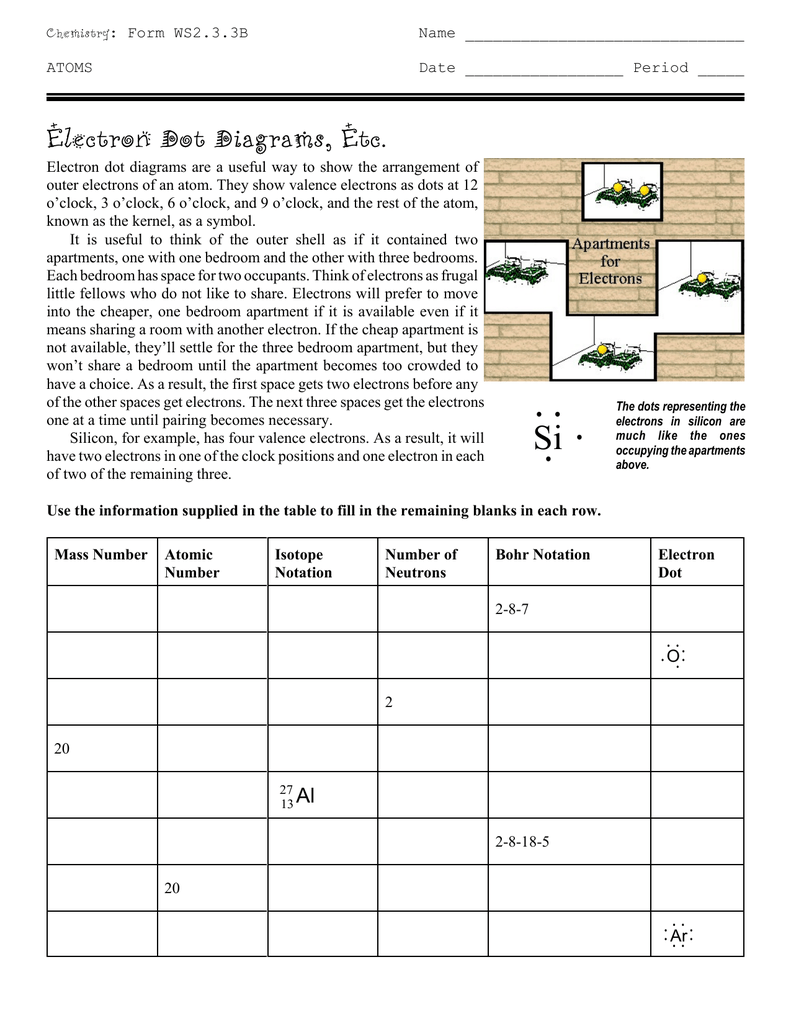Use the information supplied in the table to fill in the remaining blanks in each row. Mass Number Atomic Isotope Notation Number of Bohr Notation Electron Number Neutrons Dot 2-8-7 2 20 AI 13 2-8-18-5 20 :Ar:
Use the information supplied in the table to fill in the remaining blanks in each row. Mass Number Atomic Isotope Notation Number of Bohr Notation Electron Number Neutrons Dot 2-8-7 2 20 AI 13 2-8-18-5 20 :Ar:
Chemistry: The Molecular Science
5th Edition
ISBN:9781285199047
Author:John W. Moore, Conrad L. Stanitski
Publisher:John W. Moore, Conrad L. Stanitski
Chapter5: Electron Configurations And The Periodic Table
Section: Chapter Questions
Problem 116QRT
Related questions
Question

Transcribed Image Text:Chemistry: Form WS2.3.3B
Name
ATOMS
Date
Period
Électroi Dot Diagrams, Étc.
Electron dot diagrams are a useful way to show the arrangement of
outer electrons of an atom. They show valence electrons as dots at 12
o'clock, 3 o'clock, 6 o'clock, and 9 o'clock, and the rest of the atom,
known as the kernel, as a symbol.
It is useful to think of the outer shell as if it contained two
apartments, one with one bedroom and the other with three bedrooms.
Each bedroom has space for two occupants. Think of electrons as frugal
little fellows who do not like to share. Electrons will prefer to move
into the cheaper, one bedroom apartment if it is available even if it
means sharing a room with another electron. If the cheap apartment is
not available, they'll settle for the three bedroom apartment, but they
won't share a bedroom until the apartment becomes too crowded to
have a choice. As a result, the first space gets two electrons before any
of the other spaces get electrons. The next three spaces get the electrons
one at a time until pairing becomes necessary.
Silicon, for example, has four valence electrons. As a result, it will
have two electrons in one of the clock positions and one electron in each
of two of the remaining three.
Apartments
for
Electrons
Si
The dots representing the
electrons in silicon are
much like the ones
occupying the apartments
above.
Use the information supplied in the table to fill in the remaining blanks in each row.
Mass Number Atomic
Isotope
Notation
Number of
Bohr Notation
Electron
Number
Neutrons
Dot
2-8-7
20
AI
2-8-18-5
20
Expert Solution
This question has been solved!
Explore an expertly crafted, step-by-step solution for a thorough understanding of key concepts.
This is a popular solution!
Trending now
This is a popular solution!
Step by step
Solved in 2 steps with 2 images

Knowledge Booster
Learn more about
Need a deep-dive on the concept behind this application? Look no further. Learn more about this topic, chemistry and related others by exploring similar questions and additional content below.Recommended textbooks for you

Chemistry: The Molecular Science
Chemistry
ISBN:
9781285199047
Author:
John W. Moore, Conrad L. Stanitski
Publisher:
Cengage Learning

Chemistry & Chemical Reactivity
Chemistry
ISBN:
9781337399074
Author:
John C. Kotz, Paul M. Treichel, John Townsend, David Treichel
Publisher:
Cengage Learning

Chemistry & Chemical Reactivity
Chemistry
ISBN:
9781133949640
Author:
John C. Kotz, Paul M. Treichel, John Townsend, David Treichel
Publisher:
Cengage Learning

Chemistry: The Molecular Science
Chemistry
ISBN:
9781285199047
Author:
John W. Moore, Conrad L. Stanitski
Publisher:
Cengage Learning

Chemistry & Chemical Reactivity
Chemistry
ISBN:
9781337399074
Author:
John C. Kotz, Paul M. Treichel, John Townsend, David Treichel
Publisher:
Cengage Learning

Chemistry & Chemical Reactivity
Chemistry
ISBN:
9781133949640
Author:
John C. Kotz, Paul M. Treichel, John Townsend, David Treichel
Publisher:
Cengage Learning

General Chemistry - Standalone book (MindTap Cour…
Chemistry
ISBN:
9781305580343
Author:
Steven D. Gammon, Ebbing, Darrell Ebbing, Steven D., Darrell; Gammon, Darrell Ebbing; Steven D. Gammon, Darrell D.; Gammon, Ebbing; Steven D. Gammon; Darrell
Publisher:
Cengage Learning

Chemistry: An Atoms First Approach
Chemistry
ISBN:
9781305079243
Author:
Steven S. Zumdahl, Susan A. Zumdahl
Publisher:
Cengage Learning
